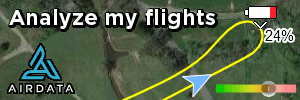This touches on exactly my thoughts (still trying to wrap words around them.) Remote ID should be an absolute necessity for BVLOS (which would likely include package delivery) but our current line-of-sight system for smaller area surveys, fpv flying, real estate photography, cinema, etc. seems to be working fine for those that are following the rules.
Side note 5: I'm still concerned about privacy. I know airspace is different from other things, but would we want the gov't recording every phone call? Recording every movement of our phone? Recording everywhere we drive (along with speeds). Recording every purchase? I know a lot of that info is out there, but at least the gov't presumably has to pass through some checks and balances to get access to it. From a gov't perspective it would be great to feed all this into a cloud with deep learning and automatically bust everyone who strays out of their figurative lane for a moment. I know some full scale aviation telemetry data is recorded and public (someone wrote a tweet bot to flag flights that looked like they were circling and comes up with lots of interesting flights.) But I wonder how full scale pilots/AOPA would feel about all their flight telemetry data being sent to the cloud in order to automatically catch anyone breaking a regulation.
I hate when regulations make normal people illegal or makes them afraid of doing normal stuff because it might be a little near the edge of all these draconian regulations. I think the freedom and privacy advocates should speak up too.
The concerns you reference above are things that, unfortunately, I believe a great many people don't understand with respect to the current state of data collection technology, government, and business.
Currently, every phone call from a foreign country to or from the U.S has some portion of it recorded and retained by government agencies. ALL digital media transmitted is recorded and retained by government agencies. First Class mail is (and has been for quite a long time) being opened and inspected without first obtaining a search warrant. Cellular data is routinely extracted, tracked, recorded, and used by government agencies at whim. Our military captures and utilizes cellular data outside of the U.S. for identifying, tracking, and remotely killing high value targets. Anything you cell phone contains, from data you are aware of to data you are not aware of, like the name and location of all towers accessed, can be extracted in seconds as an aircraft flies nearby. Police agencies employ cell tower "spoofers" to capture data from cell phones passing nearby without a warrant. Your travel via private vehicle is tracked through the use of license plate readers mounted on traffic lights and other elevated platforms. Vehicle contents are scanned using back scatter technology as vehicles, both private and commercial, pass by select highway locations. Airports, shopping centers, Amazon Ring security systems, are constantly capturing facial images that are shared with government agencies and private security business for the purpose of developing a vast facial recognition, instantly accessible database. Post a facial image of Facebook and their facial recognition programs will provide a name. Amazon is so aggressive with this they provide Ring systems to police departments to be used in public give away programs under the guise of improving community safety. Personal credit card use is tracked by the IRS to assure spending habits are not out of line with reported income. With the exception of data collected by a couple of high level, extremely secretive government agencies, all this information, and more, is being commonly accessed or shared between businesses
and government agencies.
Pretty much everything we do is recorded, either by private entities as a source of salable data, of by government agencies where it is routinely exchanged with other agencies without need of a request.
Data is power. With enough data we can identify, track, predict, isolate, restrict, destroy anyone at will. It requires only a few weeks of monitoring to capture enough data to establish a "pattern of life". From that point you have all you need to manipulate someone's future, without ever leaving the confines of an office cubicle. Iraq and Afghanistan have been great learning tools in the development of these practices, which are employed daily in many locations around the world.
The tracking and retention of flight data for every flight for every drone is something that troubles me greatly. This is not done with full scale aviation. Even after 2020's ADS-B mandate there are a great many places a manned aviation pilot can hop in a plane and fly as desired with no filing of a flight plan, no broadcasting of identity or position, nobody recording time, position, movement, altitude. If the government is seriously concerned with public safety it makes sense to closely monitor the segment of aviation that has the potential to do the most damage or destruction with any individual flight. But that is not what is being done.
The acronym for remote identification of drones, RID, can't be coincidental. "Rid" is pretty much what will be done with most of the equipment currently in use.





